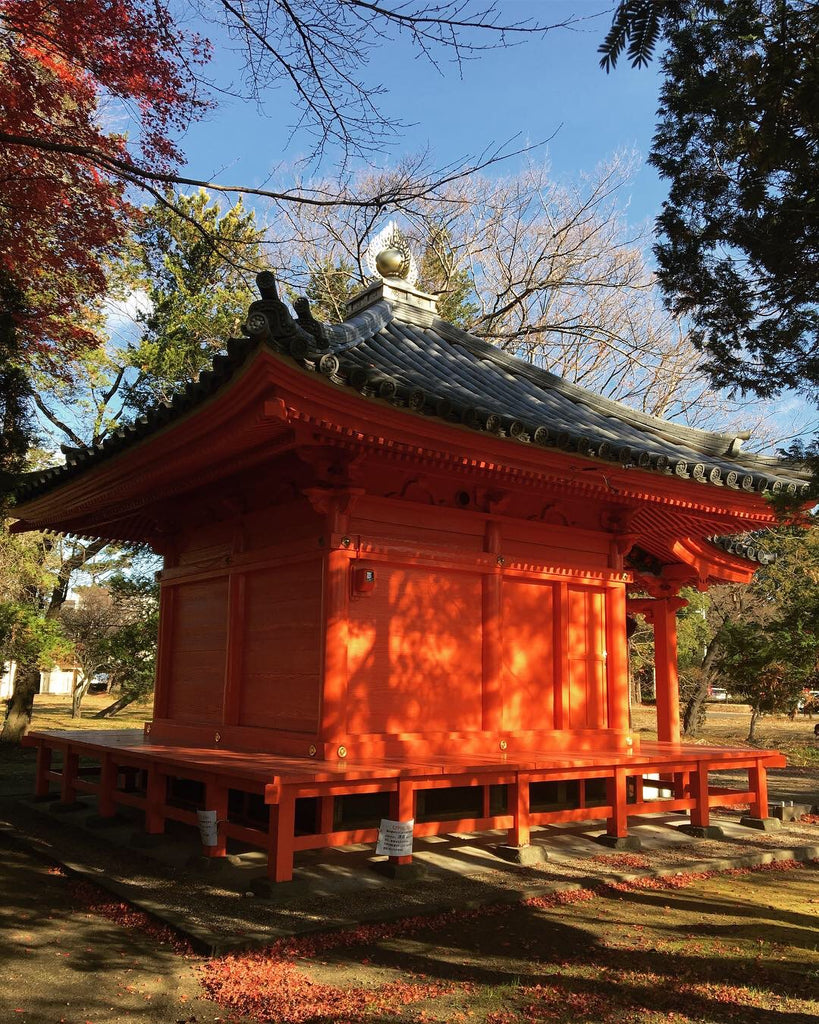Red

In almost all of my paintings or jewelry, you will find a touch of red somewhere. This habit of mine can be traced back to October of 1999, during my first trip to Tohoku, Japan. During my travels, I particularly enjoy the first impressions of the landscape. Having arrived in autumn, the colors were at their most vivid and intense.
Some of my most lingering memories of my first month in Tohoku were seeing the red Torii gates of Shinto shrines, Buddhist temples all in contrast in with the deep autumn colors. It was an all around sensory experience, I can still recall the scent of healing hot spring baths, the scent of hinoki and sulphur in the chilled autumn air.
All of these sensations brought to life the power and energy of the earth, and left an indelible influence in my life and work. When I began doing enamel jewelry the colour red became a constant. It never ceases to inspire and when wearing red, it brings a distinct energy and confidence, while also providing a reminder of our source.

As you may know, red is one of the most ubiquitous colors in Japanese culture. The color red is symbolic of power, strength, joy, and happiness. It is considered an auspicious colour, especially with white (as it is used in the national flag). It is also often seen at Shinto shrines, as “shuiro” or vermillion is believed to ward off evil and bring good luck.
There are many traditional shades of red or aka in Japanese, shuiro (vermilion) , enji (dark red), karakurenai (crimson or Chinese red) , hiiro (scarlet) safflower red (benibana) and akaneiro (madder red) are just a few.. Japanese colour names are endless and intricate in colour and hue.
Ranging from orange to deep wine hues, red has had a depth of meaning in world cultures and art throughout history. It is symbolic of love in western cultures and in many cultures, red symbolizes, power, strength, success, joy and good fortune.

In ancient history, red colors were created using various pigments, here are a few:
- Rubia Akane/ madder which produces a dye extracted from the roots and ranges from pink to deep red.
- Safflower/Benibana: the darkest colour of safflower ranges from deep red, orange to rose. Benibana was once used in cosmetics as lip or cheek rouge.
- Cinnabar: Cinnabar red is an orangish red pigment made from the ore of oxidized mercury found in nature, from volcanic deposits and hot springs. Cinnabar is also known as vermilion, they are chemically the same however cinnabar refers to the mineral and vermilion is the pigment. Cinnabar or vermilion is a perfect representation of its inner earth origins.
- Kermes: Crimson red , which inclines toward purple, was made from the dried bodies of tiny female scale insects called kermes which fed on the sap of certain oak trees and were harvested to produce dyes and paints. Over time kermes became less used and cochineal became the dye of choice one of the reasons was that it took twelve times the amount of kermes to achieve the color intensity of the cochineal.
- Cochineal: Both scarlet which is an orangey red and crimson red were rendered from dried and pulverized scale insects, cochineal are cactus eating insects native to tropical and subtropical areas of North and South America.
You can see how the many shades of red still inspire and feature in my latest work on my online shop! Here are two pieces that feature red more prominently:

--------------------------
赤
OCT 23, 2022
私の絵画やジュエリーには、どこかに少しだけ赤い色が添えてあるのに気が付かれることでしょう。この習慣は、1999年10月に初めて日本、そして東北地方へ旅したことに遡ります。旅ではいつも、その土地の風景が持つ第一印象を楽しみにしています。来日したのは、秋の自然が色彩を鮮やかに力強く放つ、まさに最高潮の時期でした。
東北で過ごす最初の月に見た、深い秋色につつまれた鳥居や寺院のコントラストは、いつまでも心に残っています。また、ひんやりした秋の空気のなかで感じた温泉の癒されるような香り、檜や硫黄の芳香、その感覚は今でも思い出すことが出来ます。
これらの感覚は、日常に大地の生命力とエネルギーを吹き込み、私の人生と作品に消えることのない影響を残しました。ジュエリーをエナメル加工する際には、繰り返し赤を使うようになりました。赤のインスピレーションは止むことなく、身に着けると自身の起原を感じるとともに、独特のエネルギーと自信を得ることが出来るのです。
ご存知のとおり、日本文化においては、あちらこちらで赤を目にすることが出来ます。赤い色は、力、強さ、歓び、幸せのシンボルです。特に白とのコンビネーションは(国旗に使用されるように)縁起の良い色合いとされ、また、神社でよく見られる“朱色”は魔除けとなり吉運をもたらすと信じられています。
日本には少しずつ色調が変わる伝統的な赤が沢山あります。朱色、臙脂、唐紅、緋色、紅花、茜色などはほんの一例…色彩と色相がとても複雑で、色の名前は限りなく存在するように思えます。
オレンジから深いワインにおよぶ赤の色相は、歴史を通して世界中の文化や芸術に深い意味を持ち続けています。西洋のみならず多くの文化において愛のシンボルであり、力、強さ、成功、歓び、幸運の象徴となっているのです。
古代、赤は様々な顔料で作り出されました。その一部をご紹介しましょう。
·茜色:アカネの根から抽出した染料で、ピンクから深紅となる。
·紅花:深紅、オレンジから薔薇色となる。かつては口紅や頬紅にも使用された。
·朱色:火山性堆積物や温泉などで見られる硫化水銀の鉱石から採れるオレンジがかった赤
い顔料。ヴァーミリオンとしても知られ、化学的には同じものだが、朱は鉱物に、
ヴァーミリオンは顔料に属する。完璧な地球内部の表象。
·ケルメス:紫寄りの深紅で、ケルメスと呼ばれるタマカイガラムシの乾燥した雌から採取
される。樫の樹皮を吸い、染料や絵具といった用途のために繁殖された。発色
にはコチニールの12倍のケルメスを必要とするため、時とともに使われな
くなった。
·コチニール(臙脂):オレンジがかった赤と深紅、両方の緋色。熱帯および北南米亜熱帯
原産でサボテンを食料とするエンジムシを乾燥粉砕して作り出す。
多様な赤にインスパイアされた最新作は、オンラインショップでもご紹介しています!
https://suzuanjewelry.com/collections/all


